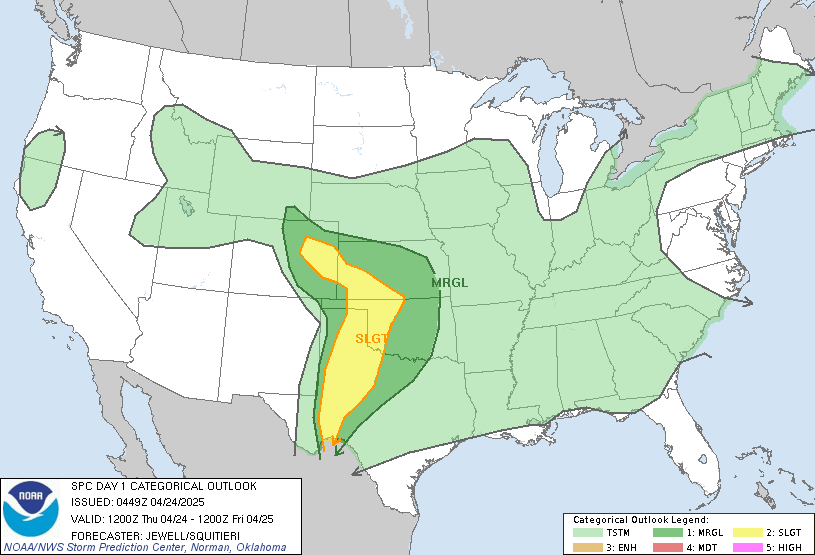LIVE MAP (ABOVE) ... SPC 2000Z Day 1 Outlook
Day 1 Convective Outlook
NWS Storm Prediction Center Norman OK
Issued by 15th OWS Scott Air Force Base IL
0245 PM CDT Tue Apr 29 2025
Valid 292000Z - 301200Z
...THERE IS AN ENHANCED RISK OF SEVERE THUNDERSTORMS FROM PARTS OF
WEST TX INTO SOUTHWEST OK... AND FROM THE OHIO VALLEY INTO THE LOWER
GREAT LAKES...
...SUMMARY...
Scattered severe thunderstorms are possible within a broad swath
from the Lower Great Lakes to the southern High Plains, mainly
during this afternoon to evening. Corridors of greater threat are
expected over the Upper Ohio Valley/Lower Great Lakes and in parts
of west Texas into southwest Oklahoma.
...Synopsis...
Satellite imagery shows a well-defined shortwave trough moving
through central Ontario and the adjacent Upper Midwest, and a mature
cyclone centered over the central UT/AZ border. The northern
shortwave trough is forecast to move eastward across the Great Lakes
and eastern Canada today while also transitioning to a more negative
tilt. The UT/AZ cyclone is expected to progress southeastward across
AZ and into western NM as an embedded shortwave trough moves through
its base across northern Mexico and into the southern High Plains.
Surface analysis places a low over Ontario, with a cold front
extending southwestward from this low into central OK where another,
weaker surface low exists. The front continues westward from this
second low across the TX Panhandle and through central NM. The
northern low is forecast to progress eastward across eastern Canada,
moving just ahead of its parent shortwave trough, ending the period
over the Canadian Maritimes. The associated cold front will also
push eastward moving through the OH and TN Valleys, and much of the
Northeast. Southern/western portion of the front will make limited
southerly/southeasterly progress, with its position becoming more
regulated by repeated convective outflow throughout the day.
Numerous thunderstorms, some severe, are occurring along the
eastward progressing cold front in OH, as well as farther southwest
across the southern Plains near the stalled boundary.
...Ohio Valley into the Lower Great Lakes...
Ongoing clusters of thunderstorms across IL extend through OH.
Strong low/midlevel flow will support development of organized storm
clusters, along with some potential for discrete or embedded
supercells. Scattered damaging winds will be possible, with some
potential for swaths of more concentrated wind damage if any
organized linear segments develop. The strongest low-level flow will
be displaced north of the region, but 35-50 kt in the 850-700 mb
layer will support sufficient low-level shear for some supercell
and/or line-embedded tornado threat. Isolated hail could also
accompany any persistent supercell structures.
...West TX into the Ozarks...
Current satellite and radar show convection from OK through the
Ozarks. Model guidance suggest this activity will continue to
evolve, tracking northeastward.
Another round of thunderstorms is occurring both along the
outflow-modulated cold front in OK and northwest TX and along the
dryline in West TX as the air mass has destabilized. Strong buoyancy
and shear will support supercells, particularly from west TX into
southwest OK during the late afternoon where low-level convergence
will be strongest. Large to very large hail will be the primary
threat initially, but strong cold pools and close storm proximity
should result in several clusters capable of strong to significant
gusts. A mesoscale corridor of greater tornado potential may
materialize just east of the surface low where stronger
southeasterly low-level flow and higher low-level moisture may
overlap.
..15_ows.. 04/29/2025
Read more CHECK UPDATE ZOOM GRAPHIC
http://dlvr.it/TKSFGJ
Windy.com Temps | Gusts | WU KORD KPWK |
CLICK for this month's BIG night sky ... | RADAR FULL MAP SCREEN |
|---|
MOBILE DEVICE? Turn sideways. Weather conditions directly above are near Lakefront. Top tabs refer to O'Hare (official).
Archives for the SPC Convective Outlook are updated daily (approximately) with a live map at the beginning of each article. Follow the link at the end of the article to check for current updates on the NOAA/NWS Storm Prediction Center website. Also, see Archives for Chicago's hourly weather data on CARDINAL NEWS Magazine.
CONVECTIVE | TORNADO | WIND | HAIL
O'Hare International Airport KORD
(Arlington Heights South)
Chicago Executive Airport KPWK
(Arlington Heights North)
Tuesday, April 29, 2025
SPC Apr 29, 2025 2000 UTC Day 1 Convective Outlook
SUNRISE AND SUNSET TIMES IN UTC (if you're not logged in to Google)
CHICAGO UTC-6 during CST (Central Standard Time, e.g., winter)
CHICAGO UTC-5 during CDT (Daylight Savings Time, e.g., summer)
CHICAGO UTC-6 during CST (Central Standard Time, e.g., winter)
CHICAGO UTC-5 during CDT (Daylight Savings Time, e.g., summer)





















